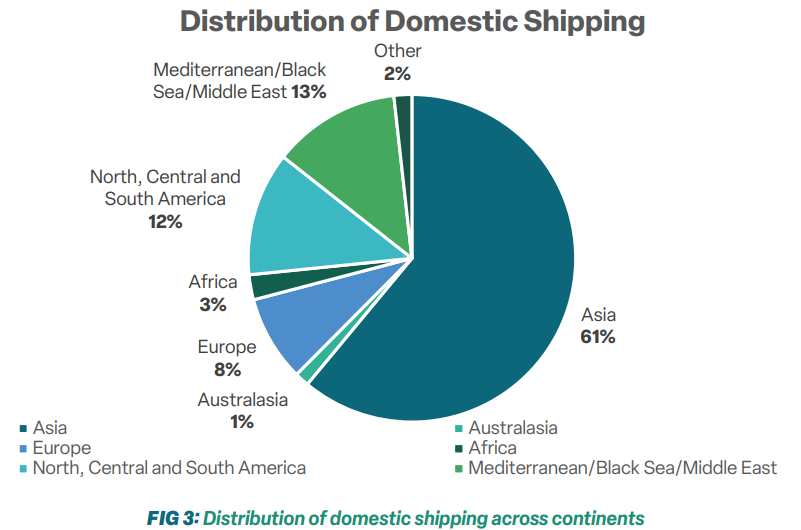A new report by IMOCARES has highlighted key actions to curb greenhouse gas (GHG) emissions from domestic shipping in Africa and the Caribbean.
The “Decarbonizing Domestic Shipping: Insights from Africa and the Caribbean” report, developed by the IMO Coordinated Actions to Reduce Emissions from Shipping initiative (IMO CARES), underscores the critical role of domestic shipping in developing countries, while noting its significant contribution to global GHG emissions.
Emissions from domestic shipping and decarbonization trends
Domestic shipping accounts for 26.2% of total shipping emissions when considering domestic voyages, and 9.2% for ships engaged exclusively in domestic operations. According to the report, decarbonization trends, facilitated by measures like EEDI, EEXI, CII, MBM, and GFS, are expected to indirectly influence emission reductions in this portion of domestic shipping.
However, ships engaged in domestic voyages and less than 400 GT in size are often required to follow measures as required by their respective administrations. As a result, these ships may not experience decarbonization trends similar to international shipping.

Key findings and recommendations
To support decarbonization of the sector, the report analyses domestic fleets in African and Caribbean Small Island Developing States (SIDS) and Least Developed Countries (LDCs), outlining priority areas for action:
-
National action plans (NAPs) – Develop and implement tailored NAPs to address the specific needs of domestic shipping in SIDS and LDCs, aligning with global climate goals and regional priorities.
-
Stakeholder collaboration – Strengthen partnerships among governments, ports, technology providers, and industry players to overcome barriers such as limited funding, regulatory gaps, and technological challenges.
-
Fleet renewal & ports as energy hubs – Invest in sustainable port infrastructure (e.g., shore power systems, alternative fuel bunkering) and promote fleet renewal with energy-efficient and zero-emission technologies.
-
Capacity building & financing – Support training programs and innovative financing mechanisms to facilitate the adoption of green technologies and enable the transition to net-zero domestic shipping.
Collaboration is key
The report calls for significant investments in zero-emission technologies, capacity building, and policies to support sustainable practices. It emphasizes that collaboration among stakeholders is essential, with pilot programmes and technology trials playing a key role in scaling up widespread adoption of clean technologies.
Domestic shipping is a lifeline for SIDS and LDCs, ensuring food and energy security, enhancing connectivity, and creating jobs. At the same time, its decarbonization is critical for achieving IMO’s greenhouse gas reduction goals. This report serves as a roadmap for relevant stakeholders in their decarbonization efforts
… said IMO CARES project manager, Anton Rhodes.
The evolving role of ports in decarbonization
As the transition to zero-emission shipping progresses, the role of ports has evolved from being mere cargo transfer hubs to becoming energy hubs. As with international shipping, ports serving domestic ships are crucial nodes in the supply chain and therefore play a vital role in the decarbonization of this sector.
Key areas to focus on for port decarbonization
When considering the decarbonization of ports, three key areas must be taken into consideration: the port–ship interface, port activities, and the port-cities interface. Ports can support and speed up the transition to zero-emission domestic shipping through port–ship operational measures and the establishment of sustainable infrastructure, such as alternative fuel and shore power systems.
Technological innovations for reducing emissions
Additionally, embracing automation, digitalization, electrification, and the use of cleaner fuels can effectively reduce emissions from port activities.



































































